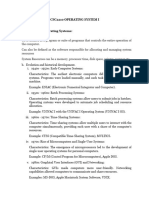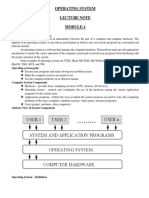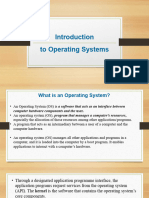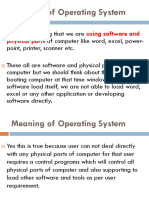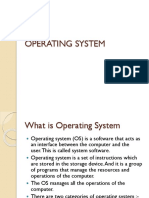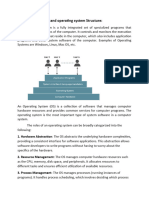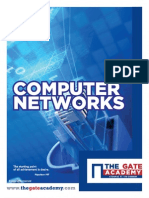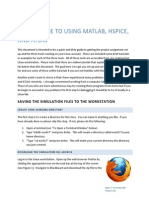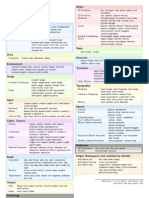What is Operating System?
Operating System: An operating system (OS) is essential software
that manages hardware resources and provides various services to
application software. It acts as an intermediary between the computer
hardware and the user, enabling you to interact with the machine and run
programs. In simpler terms, the OS helps you run applications, manage
files, control hardware devices, and perform basic computing tasks.
Key Functions of an Operating System:
1. Process Management:
o The OS manages processes, which are programs that are running on the computer.
It allocates resources (CPU time, memory) to these processes, schedules them to
run efficiently, and ensures they execute without interfering with each other.
2. Memory Management:
o The OS is responsible for managing the computer's memory (RAM). It keeps
track of memory allocation and ensures that each process has enough memory
while preventing one process from overwriting the memory of another. It also
manages virtual memory when physical memory is insufficient.
3. File System Management:
o The OS organizes and manages data stored on a computer’s storage devices (like
hard drives or SSDs). It handles file creation, deletion, access, and organization.
This includes using directories (folders) to structure files and ensuring proper
access control.
4. Device Management:
o The OS controls the communication between the computer and peripheral
devices, such as printers, keyboards, mice, monitors, hard drives, and USB
devices. It uses device drivers to allow software to interact with hardware.
5. User Interface:
o The OS provides a user interface (UI) to interact with the system. This can be a
graphical user interface (GUI), where users interact with visual elements like
windows, icons, and buttons (e.g., Windows, macOS), or a command-line
interface (CLI), where users type commands (e.g., Linux, MS-DOS).
6. Security and Access Control:
o The OS ensures that unauthorized users don’t access the system or its resources. It
uses authentication (such as passwords) and authorization to grant or deny access
to files, programs, and system settings.
7. Networking:
o The OS enables networking functionality, allowing computers to connect to other
devices or systems (e.g., over the internet or a local network). It manages
protocols like TCP/IP, handles connections, and manages data transfer.
8. Resource Allocation:
� o The OS allocates system resources (CPU, memory, disk space, etc.) among
various applications and users, ensuring efficient and fair use of resources.
Difference between Windows and DOS operating
system.
Feature Windows DOS
Interface Graphical User Interface (GUI) Command-Line Interface (CLI)
Multitasking Yes (multitasking, multiple programs) No (single-tasking)
Advanced file management with Basic file management through
File Management
Explorer commands
Hardware Support Extensive, including modern devices Limited, manual configuration needed
Resource Dynamic memory allocation, virtual Basic memory management, limited
Management memory memory
Security Built-in security, user permissions No security features
System Stability Higher stability, error handling Prone to crashes, no error recovery
Software Supports modern software and
Only runs legacy DOS applications
Compatibility applications
Networking Advanced networking support Very limited networking capabilities
Conclusion:
Windows is a modern, full-featured, user-friendly operating system that supports multitasking,
modern hardware, a GUI, and is capable of running complex applications.
DOS is an older, simpler, command-line-based operating system primarily used for running
single-task programs on older computers. It lacks many of the features and capabilities found in
modern operating systems like Windows.
While DOS was widely used in the early days of personal computing, it has largely been
replaced by more powerful systems like Windows, which provide better usability, functionality,
and support for modern computing needs.
� Computer
Assignment
TOPICS
:
Operating System.
Difference between Windows and DOS
Operating system.
Name : Zunayisha Ejaz
Class : First Year
GR No : 24
Faculty : Biomedical
Session : 2024-2025
